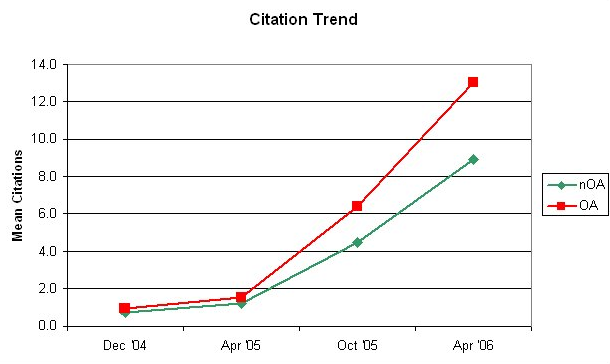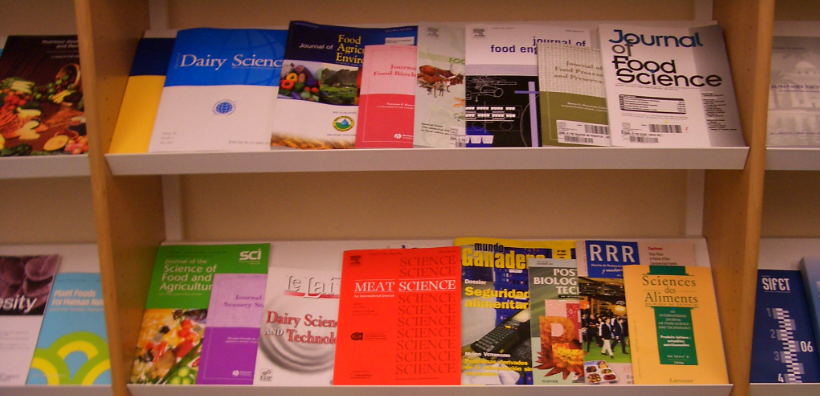
Open access ‘boosts citations by a fifth’
By David Matthews| Open access papers attract up to a fifth more citations than those locked away in closed journals, a new study has found.
Jim Ottaviani, librarian at the University of Michigan, looked at what happened when his institution made papers available through its repository and found that “an open access citation advantage as high as 19 per cent exists”.
And better-cited papers gained more from being open access, found “The Post-Embargo Open Access Citation Advantage: It Exists (Probably), It’s Modest (Usually), and the Rich Get Richer (of Course)”, published in Plos One. “When an article benefits from being OA, it benefits a lot,” the paper concludes.
Previous studies that attempted to determine whether an open access citation advantage exists have been dogged by the difficulty of finding comparable samples of open-access and subscription-only articles.
For example, it could be that authors select only their best articles to be made public in an otherwise closed journal by paying an article processing charge, meaning they get more citations regardless of the publishing format.
The study got around this problem by looking at the citation rates of thousands of articles after they had been made public through Michigan’s repository over the past decade. This meant that Mr Ottaviani had a relatively random sample of nearly 4,000 open access papers across a range of otherwise subscription-only journals.
It looked at papers that had been made open access only in a university repository (so-called green open access). Although these articles are normally easy to find via search engines, had they been made open access through their journal (referred to as gold open access), they might have garnered even more citations, the paper points out.
Although the paper finds that a citation advantage exists, it is smaller than in some other studies that have looked at the same question, and found that open access boosts citations by up to 172 per cent.
SPARC Europe, an organisation made up of European university libraries and research institutes that campaigns for research openness, has collated 70 studies that looked at whether open access provides a citation advantage and found that 46 of them did.
That paper concludes by recommending a new study involving a greater mix of subjects (Mr Ottaviani’s paper looked mainly at physical science, health science and engineering articles) and more than one university, which it says would produce even more robust results. Read more

Open Access Academic Journals Gaining Broad Readership
By Henderson| The publishing industry has been witnessing several technical and strategic changes over the years and Open Access publishing is one of the popular publication models that has received wider acknowledgement from the scientific community.
Open access publishing is producing 2 million articles annually and increasing global employment in the publishing industry. The present observed annual growth of article publishing through the Open Access model is at a rate of 7.5% to 10% every year.
With its 700+ open access journals and 3000+ International Conferences across the globe, OMICS Group is all set to provide open scientific information platforms, facilitating scientific knowledge sharing through the networked communities across the globe. As of now OMICS Group is getting 30+ million readers to its journals and conferences.
Open Access publication is gaining popularity due to increased online connectivity as it could reach millions of readers within no time, facilitating archiving, indexing, data mining, retrieving, and rapid distribution of research information. Hence, quick dissemination of valuable scientific innovations and knowledge transfer is taking place across the globe.
The number of researchers and authors trusting the Open Access publishing system is on the rise steadily by 5% each year and as many as 10 million authors are contributing through open access platforms now. No doubt, Open Access publication is going to remain as the most favorable publication model in the future as the subscription-based publishing and indexing sites are disappearing gradually with scholars and scientists getting relevant information sources from Open Access Journals.
OMICS Group is one of the pioneering Open Access publishers to rely on this philosophy, which assessed the power of sophisticated web technologies and its impact on publishing in those initial days. Today’s modern world is progressively looking at the Open Access providers for scientific information as they are transparent in providing equal access to all, facilitating faster development of research and publication in science, technology, medicine and commerce.
With 700+ open access journals, OMICS Group is a fertile global forum for discussion and knowledge sharing and OMICS Journals are attracting more than 15 Million unique visitors across the globe. These two sites are accounting for 40% journals out of 700 supported by the publisher. Moreover, 70% of the visitors to the sites comprise researchers from USA, India, UK, Japan, Germany, Italy, Australia, Brazil and South Korea, which have been serving as a global hub for scientific research. Approximately, 25% of visitors are flocking from the USA alone, and 20% of its visitors are from India.
OMICS journals encourage well-researched original articles, reviews, case studies, commentaries, technical notes and short communication for publication. Our team of over 75,000 well-built editorial board comprising veteran and accomplished scholars, researchers and scientists strives hard to provide the necessary inputs to enrich the submitted manuscripts. We follow a thorough, single-blind peer review of the manuscripts to maintain the best publication standards.
Dr Srinubabu Gedela announced, As of August 2016 OMICS Group achieved the milestone of 30 million readers. OMICS, iMedPub llc and Conference Series llc schedules 3000+ global conferences for 2016-2017. Association with more than 1000 global reputed academic, societal collaborators, OMICS Group is facilitating great networking, B2B2C opportunities, product launch and promotions through its events. Read more

US Gov’t Takes On Predatory Publishers
By Carl Straumsheim| The Federal Trade Commission on Friday filed a complaint against the academic journal publisher OMICS Group and two of its subsidiaries, saying the publisher deceives scholars and misrepresents the editorial rigor of its journals.
The complaint, filed in the U.S. District Court for the District of Nevada, marks the first time the FTC has gone after what are often known as “predatory” publishers. Such publishers exploit open-access publishing as a way to charge steep fees to researchers who believe their work will be printed in legitimate journals, when in fact the journals may publish anyone who pays and lack even a basic peer-review process.
Ioana Rusu, a staff attorney with the FTC, said in an interview that the commission is responding to a growing number of calls from people in academe for some sort of action to be taken against publishers that take advantage of scholars wishing to publish in open-access journals.
“There was definitely a sense that nobody had done anything about it,” Rusu said. “Now we’re watching.”
OMICS’ business practices have been scrutinized for years. The company, based in Hyderabad, India, publishers more than 700 open-access journals, and has created a number of imprints — including iMedPub, also named in the complaint — to expand its presence in the scholarly publishing market. Several of OMICS’ journals have names similar to other, legitimate journals, which critics say is an attempt to confuse scholars.
“If anything is predatory, it’s that publisher,” said Jeffrey Beall, scholarly communications librarian at the University of Colorado at Denver. “It’s the worst of the worst.”
Beall is known for his lists of thousands of “predatory” journals and publishers, and he has for several years written about OMICS and other publishers on his blog. Last month, for example, he published a handful of emails sent to him by researchers caught by surprise by four-digit publication fees or struggling to withdraw their papers from OMICS journals.
Those are the kinds of practices the FTC highlighted in its complaint. OMICS, the commission alleges, does not adequately disclose that authors have to pay a publication fee, falsely claims that its journals are frequently cited and lists academic experts with no connection to the journals as editors.
“As a result, in many instances, consumers only discover that their articles will not be peer reviewed and that they owe fees ranging from several hundred to several thousands of dollars after Defendants inform them that their articles have been approved for publication. Consumers’ attempts to withdraw their articles are frequently rejected, thereby preventing them from publishing in other journals,” the complaint reads. Should the court not take action, it adds, OMICS will continue to “injure consumers, reap unjust enrichment, and harm the public interest.”
The complaint extends to OMICS’ event business, managed through the subsidiary Conference Series. According to the complaint, OMICS regularly advertises conferences featuring academic experts who were never scheduled to appear in order to attract registrants.
OMICS did not respond to a request for comment, but posted a comment to this article this morning denying all charges.
Even if the FTC is successful in its case against OMICS, the commission will only make a dent in the world of “predatory” publishing. One study by researchers at Finland’s Hanken School of Economics found that such publishers flooded the scholarly communications landscape with more than 420,000 articles in 2014, about eight times as many as in 2010.
The FTC does not intend to file thousands of complaints — nor does it have the resources to do so — but Rusu said taking action against OMICS represents the commission announcing its interest in a new field. Typically, the FTC will do so by strategically targeting “some of the most recognized and also some of the worst actors” in that space, she said.
“With a lot of our other areas in which there are bad actors, the best you can hope for is that it’s setting a precedent, … marking a line in the sand and telling people that’s not OK,” Rusu said. “We don’t care if you’re marketing debt collection or publishing.”
Rusu stressed that the FTC is not passing judgment on open-access publishing in general. “We take no sides between the traditional subscription model and the open-access model,” she said. “We believe both of them can be done in a fair, open, clear and lawful way. What we have a problem with here is people who are trying to benefit from the open-access model to scam people.”
The FTC is seeking both monetary relief for researchers that have published with OMICS and to prevent the publisher from further violations of the Federal Trade Commission Act of 1914. Read more

The Acceleration of Open Access
Does it seem like a lot is going on all of a sudden, or am I just old and out of touch? (Don’t answer that.)
I noted with loud applause the launch of SocArXiv just in the nick of time. SSRN had been a for-profit but pretty useful place to store papers in the social sciences, but it was fairly old-school; since it didn’t have the resources to make renovations, it teamed up with Elsevier and that makes it no longer useful for those who think making research findings public should be in the public interest, not in shareholders’ interest. While SocArXiv builds out its infrastructure, it’s got a place where you can put your research and good reasons why you should.
One of the reasons Elsevier acquired SSRN was to branch into supporting scientists’ entire workflow, because that’s where the action will be as the ways we share our research evolve. Well, as it turns out, there’s a non-profit that is already doing exactly this, and it’s playing host to SocArXiv. The Center for Open Science has developed a sweet platform – the Open Science Framework – where scholars can put their stuff, creating an open source infrastructure for researchers’ entire workflow. (Yes, you can! Right now! And librarians, we can explore their institutional option.) Other projects of the Center for Open Science include encouraging reproducibility and finding ways to align practices with principles, such as rewarding openness instead of incentivizing publication of research in places that are not public to most working scientists. It’s all pretty ambitious, but it’s exciting to see that people are thinking big thoughts about how to build new structures and practices that help scientists do their work while living up to their better natures. (And if you’re wondering how we got into this mess in the first place, Kevin Smith has just reviewed Catherine Fisks’ Working Knowledge, which helps explain how corporations altered our concept of copyright, authorship, and intellectual property. Yet another book I haven’t read.)
So we have a Center for Open Science building a fantastic platform for storing and sharing and Cold Springs Harbor with its bioRxiv, and MLA, which has built the MLA Commons for its members with a place to share your research and teaching materials, and now, holy smokes, the American Chemical Society, which not too long ago lobbied against open access to federally funded research, is now looking into creating their own preprint server.
And today I discover the Humanities Commons is coming?!? I feel faint. So much going on. So much positive change in the air.
One fascinating aspect of this is trying to figure out how exactly the culture is changing. Librarians found out with their institutional repositories that building it alone doesn’t make them come. Hard work doesn’t necessarily bring on a cultural shift, either; institutional affiliation has less gravitational pull than disciplines and societies. Even within disciplines, it’s hard for projects like bioRxiv and MLA Commons to attract scholars and scientists who feel the systems they are familiar with are good enough, or that making their work open is too risky or too much work. But with so many projects taking off, and with such robust platforms rolling out to challenge whatever the big corporations will have to offer, I’m feeling pretty optimistic about our capacity to align the public value of scholarship with our daily practices – and optimistic about the willingness of rising scholars to change the system.
I may have trouble keeping up with it all, but that’s okay. It’s moving in the right direction. Source InsideHigherEd

